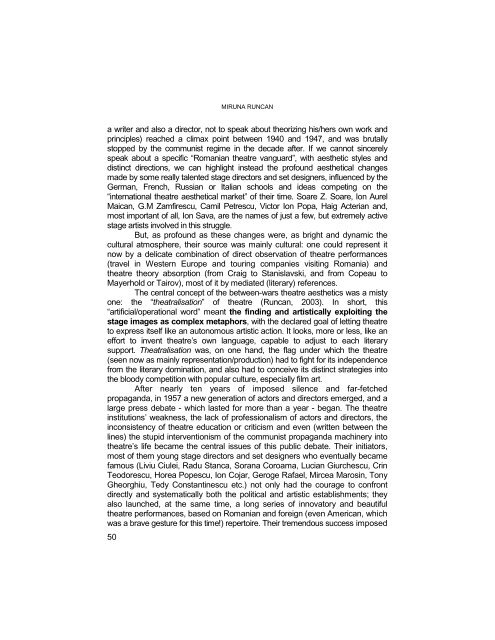studia universitatis babeÅ â bolyai dramatica teatru, film, media 2
studia universitatis babeÅ â bolyai dramatica teatru, film, media 2
studia universitatis babeÅ â bolyai dramatica teatru, film, media 2
You also want an ePaper? Increase the reach of your titles
YUMPU automatically turns print PDFs into web optimized ePapers that Google loves.
MIRUNA RUNCAN<br />
a writer and also a director, not to speak about theorizing his/hers own work and<br />
principles) reached a climax point between 1940 and 1947, and was brutally<br />
stopped by the communist regime in the decade after. If we cannot sincerely<br />
speak about a specific “Romanian theatre vanguard”, with aesthetic styles and<br />
distinct directions, we can highlight instead the profound aesthetical changes<br />
made by some really talented stage directors and set designers, influenced by the<br />
German, French, Russian or Italian schools and ideas competing on the<br />
“international theatre aesthetical market” of their time. Soare Z. Soare, Ion Aurel<br />
Maican, G.M Zamfirescu, Camil Petrescu, Victor Ion Popa, Haig Acterian and,<br />
most important of all, Ion Sava, are the names of just a few, but extremely active<br />
stage artists involved in this struggle.<br />
But, as profound as these changes were, as bright and dynamic the<br />
cultural atmosphere, their source was mainly cultural: one could represent it<br />
now by a delicate combination of direct observation of theatre performances<br />
(travel in Western Europe and touring companies visiting Romania) and<br />
theatre theory absorption (from Craig to Stanislavski, and from Copeau to<br />
Mayerhold or Tairov), most of it by <strong>media</strong>ted (literary) references.<br />
The central concept of the between-wars theatre aesthetics was a misty<br />
one: the “theatralisation” of theatre (Runcan, 2003). In short, this<br />
“artificial/operational word” meant the finding and artistically exploiting the<br />
stage images as complex metaphors, with the declared goal of letting theatre<br />
to express itself like an autonomous artistic action. It looks, more or less, like an<br />
effort to invent theatre’s own language, capable to adjust to each literary<br />
support. Theatralisation was, on one hand, the flag under which the theatre<br />
(seen now as mainly representation/production) had to fight for its independence<br />
from the literary domination, and also had to conceive its distinct strategies into<br />
the bloody competition with popular culture, especially <strong>film</strong> art.<br />
After nearly ten years of imposed silence and far-fetched<br />
propaganda, in 1957 a new generation of actors and directors emerged, and a<br />
large press debate - which lasted for more than a year - began. The theatre<br />
institutions’ weakness, the lack of professionalism of actors and directors, the<br />
inconsistency of theatre education or criticism and even (written between the<br />
lines) the stupid interventionism of the communist propaganda machinery into<br />
theatre’s life became the central issues of this public debate. Their initiators,<br />
most of them young stage directors and set designers who eventually became<br />
famous (Liviu Ciulei, Radu Stanca, Sorana Coroama, Lucian Giurchescu, Crin<br />
Teodorescu, Horea Popescu, Ion Cojar, Geroge Rafael, Mircea Marosin, Tony<br />
Gheorghiu, Tedy Constantinescu etc.) not only had the courage to confront<br />
directly and systematically both the political and artistic establishments; they<br />
also launched, at the same time, a long series of innovatory and beautiful<br />
theatre performances, based on Romanian and foreign (even American, which<br />
was a brave gesture for this time!) repertoire. Their tremendous success imposed<br />
50

















